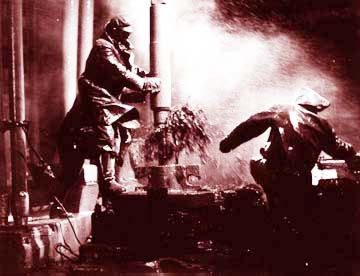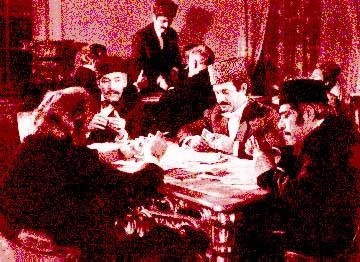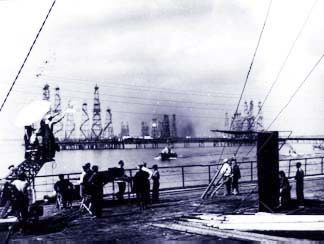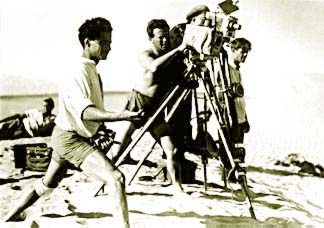|
Autumn 1997 (5.3) 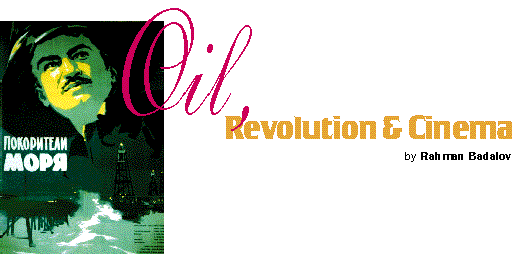 It wasn't by mere chance that the first motion picture in 1898 in Baku began with an episode about the "Fire at the Oil Gusher in Bibi-Heybat." This suburb of Baku was full of oil fields, and there were frequent fires. It was inevitable that the paths of cinema and oil would intersect. First of all, by the turn of last century, oil had already become a symbol of Azerbaijan and Baku. Oil was our main source of wealth and our main cause of problems. It's always been that way-oil, both blessing and curse. The struggle to harness this energy gushing forth has become our destiny. Therefore, it's only natural that Azerbaijani cinema would start with an episode about an oil gusher. Of course, blazing oil gushers make marvelous cinematographic material. No one can deny that. As a medium, only cinema can capture the thick oil stream bursting forth like a fiery monster. Only cinema can display such an awesome inferno in its terrifying beauty and majesty.
The legend surrounding Oil Rocks motivated the famous documentary filmmaker Roman Karmen to tackle two films-"A Novel about Caspian Oil Workers" and "Conquerors of the Sea."
"Golden Precipice" (F. Aliyev, 1980) was produced as a melodrama and has its hero enticed into the realm of big money, only to be battered into becoming a mere toy in the hands of fate. One sympathizes with the hero, overpowered by this world of "big oil." The approach to dealing with oil in Azerbaijani cinema was very narrow. In reality, the truth lay somewhere in between the melodramas and the stories which praised the "oil heroes." Neither of these two genres broached the subject of pollution or poverty. Neither showed the districts in Baku where these oil workers lived nor its destitution. All such aspects were hidden. Revolution: The Great
Illusion The Azerbaijani movies of the 1920s and 30s resembled a puppet theater. Everything was predictable. Almost always the story line included a greedy "bey" or landowner, a cynical molla (religious cleric) and a severe tsarist officer. Always playing opposite these scoundrels was a peasant, who was naive and ignorant at the beginning of the film, but gradually "regained his sight" towards the end. Usually, too, there was a character depicted as a worker full of self-confidence and always ready to "engage in struggle." Note that the worker was usually a Russian proletariat for whom solidarity was the primary goal. Identical Plots The film, "In the Name of God" (Bismillah) (A. Sharifzade, 1925) is a prime example. A greedy, conniving molla is always finding ways to cheat one of the peasants, who is so used to submission that he never imagines he can protest or resist. Only under the influence of the Revolution and Bolsheviks does the peasant realize how long he has been cheated. In the end, the people's court arrests the molla and justice wins out. In the film "Peasants" (S. Mardanov, 1939), the landowner deprives the peasant of his last horse, leaving him with no means to plough his land and dooming him to starvation. Again, the workers (Russian proletariats) explain that he could reclaim his property and that the other workers will help him. The revolutionary movement overthrows "the bloody Musavat" (referring to the Azerbaijan Democratic Republic as it was called at that time) which was protecting beys and khans. The peasant then becomes a propagator of the new socialistic life. We could go on and on listing movies with this identical plot. But let's not forget that above all, cinema is an illusion. Otherwise, we wouldn't become paralyzed with horror when we saw westerns or horror films, nor would we weep during melodramas or burst into laughter at comedies. In the history of that period, no doubt there was a lot of cruelty, but there were also grand illusions and naive beliefs which we must take into consideration. "Bismillah" and "Peasants" are expressions of this illusion-that good and evil are polarized concepts and that the oppressed can be made happy. Today, we watch these films as chronicles of the traditions of the great Russian cinematographers such as S. Eisenstein and V. Pudovkin who tried to make their films chronicle events. In the films made in the 1960s and 1970s, Soviet ideology didn't change much although the ideas were presented more artistically. Both the idealized picture of the establishment of justice in the world, the romanticizing of a fearless hero and the atmosphere of the tenseness was considered as a unique artistic game. The film, "Seven Sons of Mine" (Tofig Taghizade, 1971), was based on Samad Vurgun's "Komsomol Poem." Seven sons, like seven samurais become the seven komsomols (communist leaders) who were sent to a village to establish Soviet power. Seven sons become the romanticized images of people's heroes ready to take revenge. In all their actions, they followed their own moral code which defined their behavior and manners. Eventually, they were unconquerable. They all had different personalities, but they were always together, united around a great idea. "Seven Sons" is a folklore image embodying unity and eternity. From this point of view, there will always be seven. There were seven who entered the village, and there were seven who left despite the fact that six brothers actually died in the film, and the leader was obliged to gather six more followers around himself. The film, "The Last Mountain Pass" (K. Rustambeyov, 1972), develops around a slightly different theme. Here two former "beys" (land owners) are opposing each other. One is loyal to the ideology of the past and can't reconcile himself to the new power, the second rejects the past and accepts the power of the Bolsheviks, believing that it will establish justice. Another film is about the "26 Baku Commissars." In fact, two films were made about the Commissars. The first was directed by N. Shengelaya; the second was by A. Ibrahimov (1966). Both are interesting, not because they enable us to judge about the real lives of the Commissars, but because they develop the legends that had grown up around the Commissars. In Shengelaya's film, the Democratic Government ("the bloody Musavat") signs an agreement with the Americans. But the British manage to sabotage this agreement and pursue their own interests. They close the pipeline causing the oil to flow out of the reservoirs into the sea. In the film, we see how oil gradually covers the whole screen. This was intended as a metaphor to emphasize how badly imperialists handle oil energy. In both films, the leader of the Commissars Shaumyan says almost the same thing, "The Baku workers made a fatal mistake breaking off from revolutionary Russia and inviting the English. England has conquered half of the world and needs Baku's oil for its own interest." Hearing these words, the Baku proletariat begins supporting the Bolsheviks. The Future Just recently, Baku Film Studio
made a documentary entitled "The Contract of the Century"-the
phrase that Azerbaijanis use to refer to the contract signed
in 1994 with 11 oil companies from 7 countries for the gigantic
fields of Azeri, Chirag and the deep-water section of Gunashli.
Of course, the cinema couldn't ignore such an event. Maybe this
contract will enable us to make a big film about the big Baku
oil in the future. Such a film, no doubt, will be dramatic, it
may even have a tragic ending, but let's hope, at least, it will
be free from ideological stereotypes. |

